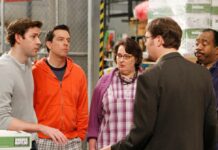Infection rates are extremely low among students and teachers in both public and private schools.
That’s according to a database created by Oster, who noticed there was no central place to track how the virus was spreading in elementary, middle and high schools and wanted to fill that need.
With the help of colleagues, she invited school districts and individual schools across the United States to submit reports twice a week on cases among students and staff members. Seventy-two percent of the participants are public schools, while 8 percent are private and another 8 percent are public charter schools.
Those biweekly reports, along with more-comprehensive school case data made publicly available by the states of New York and Texas, are graphed on a dashboard where users can see case rates among students and staff and compare them to case rates in the surrounding community.
Oster admits the data is far from comprehensive; so far, it represents 8.7 million enrolled students and 1.3 million staff members in school buildings — less than 20 percent of the nation’s K-12 population. But the results, she argues, should give policymakers pause when thinking about closing classrooms once again.
The nation’s top infectious disease expert, Anthony S. Fauci, said last night he too was a proponent of keeping schools open if at all feasible. “One of the things we need to do…is try to keep the kids in school,” Fauci, director of the National Institute for Allergy and Infectious Diseases, told CNN yesterday. “My feeling is the default condition is to keep the schools open if you possibly can.”
In schools that have opened classrooms full or part time, there are 17 daily cases for every 100,000 students.
Among staff members in those schools, the daily case rate is 31, according to the database. Infection rates are even lower among just elementary schools, underscoring research that has suggested younger kids don’t transmit the virus as much as older ones. Oster’s database shows a daily case rate of 7 among students and 17 for staff members in elementary schools.
Add in reports from schools offering only virtual classes, and the daily case rate among students holds steady at 17, while the daily case rate among staff members falls slightly to 27. That could signal that holding in-person classes is contributing only a little — or not at all — to the spread of the virus among children and teachers.
It’s possible some children could unknowingly be infected, considering kids are less likely than adults to exhibit symptoms of covid-19. But even that hypothesis hasn’t borne out; when New York City performed more than 74,000 tests in 1,224 schools in October, just 45 students and 63 staff members tested positive.
“Asymptomatic testing in many schools has not revealed giant pockets of highly contagious children,” Oster told me.
A new UNICEF report underscores Oster’s findings.
The U.N. agency said data from 91 countries shows no consistent link between reopening schools and higher rates of infection from the coronavirus. The report, which warns of a “lost covid generation,” says children are more likely to get the virus outside of school settings.
The report also stresses the deep harm to children — particularly those in vulnerable communities — by keeping them away from school. “There is strong evidence that, with basic safety measures in place, the net benefits of keeping schools open outweigh the costs of closing them,” the report says.
Yet New York City and other districts are backing away from in-person learning yet again.
All 1.1 million students in New York City’s public schools returned to remote learning yesterday, under order by Mayor Bill de Blasio (D). The announcement was fraught with tension; just minutes before de Blasio tweeted his decision on Wednesday, New York Gov. Andrew Cuomo (D) chided reporters for asking about schools and denied they’d be shuttered again.
Politico reporter Andrew Desiderio:
David Mack, BuzzFeed News’s deputy director for breaking news:
It’s not just New York that is cracking down on schools; Kentucky Gov. Andy Beshear (D) also announced he is requiring all public and private schools and all public universities to close next week. California’s major cities never even opened their public schools this fall, under pressure from powerful teachers unions.
There’s a wave of pushback.
Many people are worried decision-makers are ignoring an emerging body of evidence that kids don’t easily transmit the virus. Oster said she can see the concerns building, after most schools announced virtual plans to little pushback earlier this fall.
“In New York, they basically said schools are not a source of transmission … and we’re closing them,” Oster said. “I think there are more people who are like, ‘That’s a bit of a weird position to take.’”
Montreal health journalist Aaron Derfel:
Editor and mom of four Bethany Mandel:
Brooklyn parents described to The City frustration and stress from weeks of helping their kids with online school while juggling their own jobs. They were excited for their schools to finally open on Thursday, only to have their hopes dashed at de Blasio’s announcement.
The New York Times ran two op-eds this week criticizing decisions to keep schools virtual.
“Some things are true even though President Trump says them,” wrote opinion columnist Nick Kristof, referring to Trump’s frequent insistance that schools should be open.
Shutting schools should be the “last resort,” Kristof wrote, noting that evidence from schools in Europe hasn’t shown evidence of high transmission in schools and writing extensively about the harm to children from closing in-person school.
Contributing columnist Aaron Carroll wrote that policy makers aren’t basing their school-closing decision on statistics or science.
“Schools are essential, and should be treated as such,” Carroll wrote. “When we prioritize, they should be among the last things to close. Almost everything else should be put on pause first.”
And in The Post, contributing columnist Danielle Allen and physician Ashish Jha praised Michigan Gov. Gretchen Whitmer (D) for keeping schools open even as she closes bars and restaurants.
“We now have examples of schools at all grade levels that are being managed safely and effectively in a pandemic,” they wrote. “New data and the experiences of individual school districts demonstrate that opening schools in a pandemic with infection-control measures in place does not lead to increased transmission of the virus.”
Ahh, oof and ouch
AHH: Pfizer will seek emergency authorization of its vaccine today.
“The filing is a significant step in the effort to develop a vaccine and will move the race to its next, deliberative phase — a weeks-long process in which career scientists at the Food and Drug Administration scrutinize the data and determine if the vaccine is safe and effective,” Caroln writes.
A complete analysis of the results from Pfizer’s late-stage vaccine trial showed the vaccine to be 95 percent effective, with no serious side effects. The vaccine is also 94 percent effective in adults over the age of 65, a group among the most vulnerable to the virus, and appears to prevent both mild and severe cases of covid-19. The results, which will be reviewed by the Food and Drug Administration and an independent advisory agency, provide a spot of optimism even as the United States confronts record numbers of coronavirus cases.
Among 170 people infected with the coronavirus during the trial, 162 were in the placebo group and only eight were in the vaccine group.
If the vaccine is approved, however, it will only complete a first hurdle in containing the pandemic. While Moncef Slaoui, the head of Operation Warp Speed, has said that 20 million Americans could be vaccinated by the end of the year, It could take until spring for the general population to receive vaccines. Meanwhile, many states say that they do not have the money or resources necessary to gather data on vaccines, hire personnel and run massive vaccine distribution campaigns.
OOF: America will surpass the death rate of the darkest days from the spring, according to a new analysis.
“With cases rising as fast as they are, the U.S. could cross the threshold of 2,000 daily deaths within a month. Without a miraculous improvement in care, the United States is about to face the darkest period of the pandemic so far,” the Atlantic’s Alexis C. Madrigal and Whet Moser report.
The death rate for the coronavirus — the number of deaths divided by cases — has fallen dramatically since the early days of the pandemic, as we detect more cases and have better treatments for patients who end up in the hospital. This is one reason there were fewer deaths reported during a surge of cases in the summer, even as the number of recorded infections far surpassed the number of diagnosed cases in March and April.
But Trevor Bedford, a genomic epidemiologist at the Fred Hutchinson Cancer Research Center in Seattle, came up with a grim finding when he used data from the COVID Tracking Project at the Atlantic to analyze the deadliness of the virus, accounting for a lag between diagnosed cases and reported deaths. He found that the death rate has not gone down any further since July. “Instead, the virus has, with ruthless regularity, killed at least 1.5 percent of all Americans diagnosed with COVID-19, over the past four months,” Madrigal and Moser write.
This death rate multiplied by the record number of cases across the country suggests that the United States could see more than 2,250 deaths a day, a number well beyond the record set on April 21 of 2,116 deaths. If hospitals start to fail, the numbers could go even higher, Madrigal and Moser write.
OUCH: The Centers for Disease Control and Prevention recommends against Thanksgiving travel.
At the agency’s first news briefing in months, officials warned that friends and families could inadvertently bring coronavirus with them to holiday gatherings, putting their loved ones at risk and potentially fueling the spread of the virus through communities, Brittany Shammas reports.
“At the individual household level, what’s at stake is basically the increased chance of one of your loved ones becoming sick and then being hospitalized and dying,” said Henry Walke, the CDC’s covid-19 incident manager.
The CDC has previously advised holiday travelers to follow local guidance and take precautions, such as wearing a mask. The new guidance goes a step further, advising that “postponing planned travel and remaining at home is the best way to protect yourself and others this year.”
The public health agency is also advising against gatherings that involve members of different households, including students returning from college, who, the CDC says, should limit indoor interactions and wear masks inside the home.
The transition
Officials on Trump’s vaccine distribution team have no plans to brief the Biden transition team.
After attending a conference call between leaders of Operation Warp Speed, the federal program to fast-track a vaccine, and senators, Sen. Chris Murphy (D-Conn.) called the failure to brief the Biden team “potentially catastrophic” on Twitter, Reuters’s Patricia Zengerle and Steve Holland report.
Trump has continued to falsely maintain that he won the election, and a Trump appointee in the General Services Administration has so far refused to sign the paperwork ascertaining that Joe Biden won the election, a necessary step to start the transition process.
“It’s going to put us behind the eight ball by a matter of a month or more, and that’s lives. How many would be lost as a consequence of that, I can’t tell you,” Biden said at a news conference on Thursday after meeting with state governors.
A White House spokesman did not address plans to brief Biden’s team but told Reuters that vaccine distribution plans from the CDC and state governors were publicly available.
Despair in nursing homes
It’s not just covid-19 killing nursing home patients; deaths tied to isolation and neglect are also surging.
“As more than 90,000 of the nation’s long-term care residents have died in a pandemic that has pushed staffs to the limit, advocates for the elderly say a tandem wave of death separate from the virus has quietly claimed tens of thousands more, often because overburdened workers haven’t been able to give them the care they need,” the Associated Press’s Matt Sedensky and Bernard Condon report.
Excess fatalities beyond what would be expected in a normal year, and not directly attributable to coronavirus, could account for 40,000 deaths since March. Patients are dying from dehydration, infection and, in seemingly many cases, isolation and depression. These deaths happen at higher rates in facilities where the virus spread, perhaps a side effect of overstretched staff, some of whom may have been forced to stay home if they contracted the virus themselves, leaving the nursing home even more short-staffed.
Restrictions put in place to control the spread of the virus kept out visitors, government regulators and volunteers. As some facilities have started to open up again, “nursing home watchdogs are being flooded with reports of residents kept in soiled diapers so long their skin peeled off, left with bedsores that cut to the bone, and allowed to wither away in starvation or thirst,” Sedensky and Condon write.








